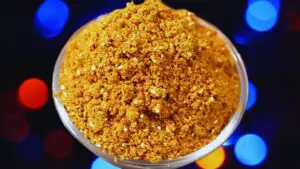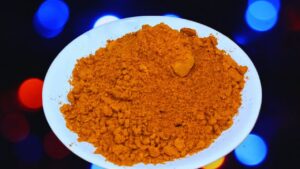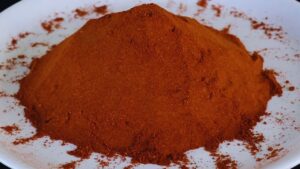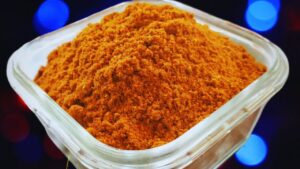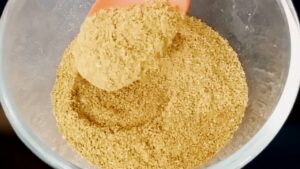Mustard powder is a spice made by grinding dried mustard seeds into a fine powder. It has a distinctive pungent flavor. Follow the simple steps below to make mustard powder at home.

KEY TAKEAWAYS
- Mustard powder is a simple yet versatile spice.
- Store it in cool dark place in an airtight container.
- Use the powder as marinade or in sauces, pickles, curries and gravies of different kinds.
- White mustard seeds will offer a slightly similar taste as traditional black mustard seed powder.
How to Make Mustard Powder? (Step by Step Guide with Images)
Step 1: Take 200 gm of clean and fresh mustard seeds in a bowl. Put the bowl of mustard seeds in the sun for 3 to 4 hours to dry them naturally.

(Pro tip: You can take black or white mustard seeds according to your preference. Here I have taken black mustard seeds. And, if you want to make the powder quickly, you may take a frying pan and heat it on a low flame on your gas stove and dry roast the mustard seeds as well, instead of drying them under the sun).
Step 2: Now, set the bowl in the shade so that the mustard seeds cool down a bit. Then take a clean and dry grinder and put the seeds in it when they are sufficiently cool.

(Pro tip: Make sure that the grinder is clean and dry. Also, ensure the mustard seeds are cool enough. Both these will prevent the powder from clumping due to moisture or heat).
Step 3: Now, grind it to a powder. Check the powder for its texture.

(Pro tip: I prefer it relatively coarse. However, you can make a fine powder of the mustard seeds. For that, you will need to grind it a couple of times more but make sure you grind them intermittently to prevent heat generation and clumping of the powder).
Step 4: When you are satisfied with the texture, transfer it into a bowl and your homemade mustard powder is ready to be used in a variety of dishes. 
Recipe Card

Mustard Powder
Ingredients
- 200 grams Mustard seeds
Instructions
- Take 200 gm of clean and fresh mustard seeds in a bowl. Put the bowl of mustard seeds in the sun for 3 to 4 hours to dry them naturally.(Pro tip: You can take black or white mustard seeds according to your preference. Here I have taken black mustard seeds. And, if you want to make the powder quickly, you may take a frying pan and heat it on a low flame on your gas stove and dry roast the mustard seeds as well, instead of drying them under the sun).
- Now, set the bowl in the shade so that the mustard seeds cool down a bit. Then take a clean and dry grinder and put the seeds in it when they are sufficiently cool.(Pro tip: Make sure that the grinder is clean and dry. Also, ensure the mustard seeds are cool enough. Both these will prevent the powder from clumping due to moisture or heat).
- Now, grind it to a powder. Check the powder for its texture.(Pro tip: I prefer it relatively coarse. However, you can make a fine powder of the mustard seeds. For that, you will need to grind it a couple of times more but make sure you grind them intermittently to prevent heat generation and clumping of the powder).
- When you are satisfied with the texture, transfer it into a bowl and your homemade mustard powder is ready to be used in a variety of dishes.
Notes
- Choose top-quality mustard seeds to make this powder.
- I prefer black mustard seeds but you can also make it with white mustard seeds if you want.
- I favor sun-drying the seeds. However, you are free to dry roast them slightly on a low flame, but do not burn them.
- Cooling the seeds is crucial as that will prevent clumping.
- Use clean and dry grinder to make the powder. This will enhance the texture and shelf life of the powder.


